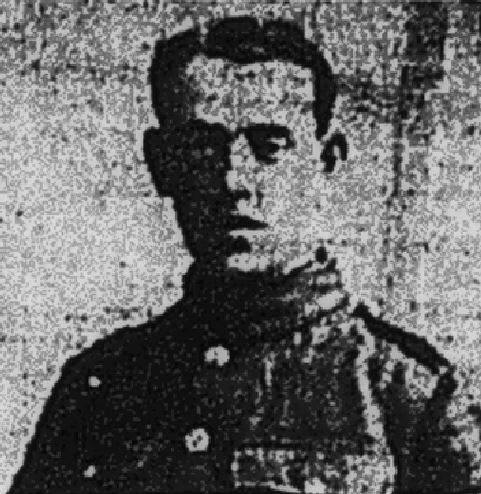L/Cpl
Charles Richards
Information about birth
|
Date of birth: 29/11/1896 |
|
Place of birth: Cwmtillery, Monmouthshire, Wales, United Kingdom |
General information
|
Profession: Coal miner |
Army information
|
Country: Wales, United Kingdom |
|
Force: British Expeditionary Force |
|
Rank: Lance Corporal |
|
Service number: 290729 |
|
Enlistment place: Abergavenny, Monmouthshire, Wales, United Kingdom |
|
Units: — Monmouthshire Regiment, 1/2nd Bn. (Last known unit) |
Information about death
|
Date of death: 27/09/1917 |
|
Place of death: Langemarck, Belgium |
|
Cause of death: Killed in action (K.I.A.) |
|
Age: 20 |
Cemetery
|
Bleuet Farm Cemetery Plot: I Row: E Grave: 48 |
Distinctions and medals 2
|
British War Medal Medal — 10/06/1921 |
|
Victory Medal Medal — 10/06/1921 |
Points of interest 2
| #1 | Place of birth | ||
| #2 | Enlistment place |
My story
Lance Corporal Charles Richards served in the Monmouthshire Regiment, 1st/2nd Battalion. This infantry unit was transformed to the Divisional Pioneer Battalion of the 29th Division in May 1916. The 29th Division was active in Flanders during the Third Battle of Ypres. The 2nd Monmouths had already been working at the frontline since early August. At the beginning of the month of September the 1/2nd Monmouthshire Regiment was stationed in Pigeon Camp, near the village of Proven. On the 20th of September the Battalion relieved the 4th Coldstream Guards Pioneer Battalion for yet another tour at the front and was stationed in Hampton Camp and Burke Camp near the village of Woesten.
From the 21st of September onwards the men worked on pioneering duties on the left flank of the offensive near the village of Langemark. The Battalion was mainly involved in consolidation works preparing the way for troops and supplies to the front; maintaining and laying roads, duckboards and tracks.
On 26 and 27 September 1917 the whole Battalion was put to work in anticipation of upcoming attacks in October 1917. “A” Company worked on roads and tracks near the Wijdendrift hamlet while “D” Company was working on trenches running from the Wijdendrift Road to Montmirail Farm. In the meanwhile “C” Company was constructing supply dumps in the vicinity and “D” Company was laying artillery tracks between Norman Junction and the Steenbeek stream.
The 2nd Monmouths suffered several casualties throughout the second half of September. While the men were working they were frequently subjected to shelling, gas and the German snipers. Especially the persistent German shellfire took its toll. According to his commanding officer Lance Corporal Charles Richards was hit in the side by shrapnel while working near Langemark. He quickly succumbed to his wounds. His comrades wanted to give him a proper burial and carried his body back to the dressing station at Bleuet Farm, where he was laid to rest on the adjacent cemetery.
From the 21st of September onwards the men worked on pioneering duties on the left flank of the offensive near the village of Langemark. The Battalion was mainly involved in consolidation works preparing the way for troops and supplies to the front; maintaining and laying roads, duckboards and tracks.
On 26 and 27 September 1917 the whole Battalion was put to work in anticipation of upcoming attacks in October 1917. “A” Company worked on roads and tracks near the Wijdendrift hamlet while “D” Company was working on trenches running from the Wijdendrift Road to Montmirail Farm. In the meanwhile “C” Company was constructing supply dumps in the vicinity and “D” Company was laying artillery tracks between Norman Junction and the Steenbeek stream.
The 2nd Monmouths suffered several casualties throughout the second half of September. While the men were working they were frequently subjected to shelling, gas and the German snipers. Especially the persistent German shellfire took its toll. According to his commanding officer Lance Corporal Charles Richards was hit in the side by shrapnel while working near Langemark. He quickly succumbed to his wounds. His comrades wanted to give him a proper burial and carried his body back to the dressing station at Bleuet Farm, where he was laid to rest on the adjacent cemetery.
Sources 2
|
Divisional Troops: 1/2 Battalion Monmouthshire Regiment (Pioneers). (The National Archives, KEW (TNA), WO 95/2295/4). https://discovery.nationalarchives.gov.uk/details/r/C14303 Further reference |
|
Dixon J., Out Since 14. A History of the 1/2nd Battalion The Monmouthshire Regiment 1914-19., (Abertillery, Old Bakehouse Publications., 2000), pg. 113-122. Sources used |
More information 3
|
Commonwealth War Graves Commission Database https://www.cwgc.org/find-records/find-war-dead/casualty-details/436629 |
|
Namenlijst (In Flanders Fields Museum) https://namenlijst.org/publicsearch/#/person/_id=90aa4cef-ec9c-45cb-ab59-ef40285ae8e3 |
|
Lives of the First World War (Imperial War Museum) https://livesofthefirstworldwar.iwm.org.uk/lifestory/3718200 |
